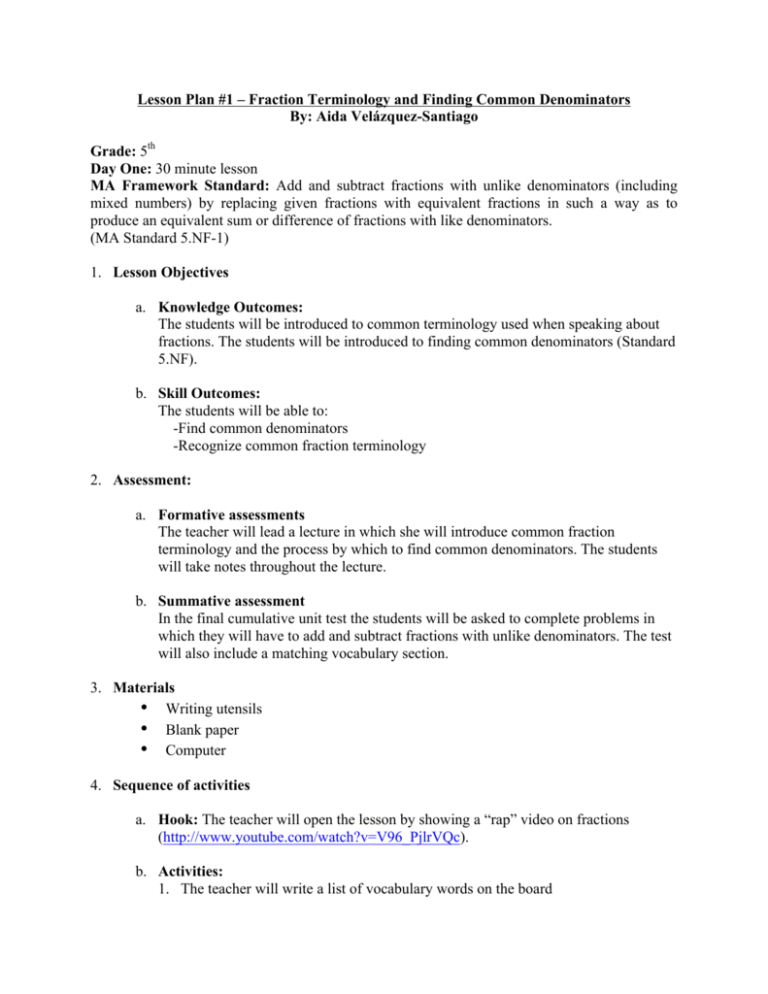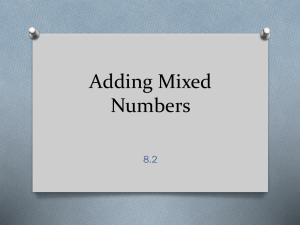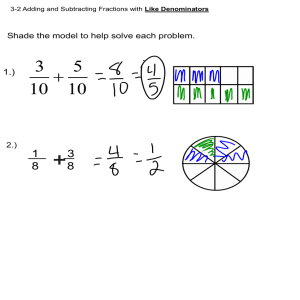Lesson Plan #1 – Fraction Terminology and Finding Common
advertisement

Lesson Plan #1 – Fraction Terminology and Finding Common Denominators By: Aida Velázquez-Santiago Grade: 5th Day One: 30 minute lesson MA Framework Standard: Add and subtract fractions with unlike denominators (including mixed numbers) by replacing given fractions with equivalent fractions in such a way as to produce an equivalent sum or difference of fractions with like denominators. (MA Standard 5.NF-1) 1. Lesson Objectives a. Knowledge Outcomes: The students will be introduced to common terminology used when speaking about fractions. The students will be introduced to finding common denominators (Standard 5.NF). b. Skill Outcomes: The students will be able to: -Find common denominators -Recognize common fraction terminology 2. Assessment: a. Formative assessments The teacher will lead a lecture in which she will introduce common fraction terminology and the process by which to find common denominators. The students will take notes throughout the lecture. b. Summative assessment In the final cumulative unit test the students will be asked to complete problems in which they will have to add and subtract fractions with unlike denominators. The test will also include a matching vocabulary section. 3. Materials • Writing utensils • Blank paper • Computer 4. Sequence of activities a. Hook: The teacher will open the lesson by showing a “rap” video on fractions (http://www.youtube.com/watch?v=V96_PjlrVQc). b. Activities: 1. The teacher will write a list of vocabulary words on the board 2. The whole class will then have a discussion guided by the teacher and as a class come up with the definitions of the vocabulary words 3. The students will take notes throughout the discussion. Typed notes will be provided to any student who’s IEP specifies they need to be scribed for. After the lesson the teacher will post all the notes on the class website. 4. Introduce students to finding common denominators 1. 3/4 + 1/5 2. List the multiples of both denominators 4: 4, 8, 16, 20, 24, 28… 5: 5, 10, 15, 20, 25, 30… 3. Look at both lists and underline those numbers that appear on both lists 4: 4, 8, 12, 16, 20, 24, 28, 32, 36, 40 5: 5, 10, 15, 20, 25, 30, 35, 40, 45, 50 4. Look for the smallest underlined number, also known as the least common denominator 5. In small groups of three the students will find common denominators for multiple fractions provided by the teachers c. Differentiation: Those students who learn best by taking notes during class will have the opportunity to do so. Typed notes will be provided to those students who’s IEP specifies they need to be scribed for. By posting the notes on the class website the notes will be available to those students who learn best by listening. d. Wrap-Up: The homework for the day will be to review the vocabulary learned during class for a minimum of 10 minutes. 5. Potential Pitfalls This lesson requires the students sit and listen for an extended period of time. Those students with ADD or ADHD may find it difficult to remain focused for the mini-lecture. Also, since the students generate the definitions for the vocabulary this lesson may take longer than the allotted 30 minutes. 6. Reflections In order to generate the definitions this lesson assumes the students have some kind of background knowledge on fractions. The teacher must be patient and ready to fill in any gaps in the students’ knowledge in order to help them come up with accurate definitions.






